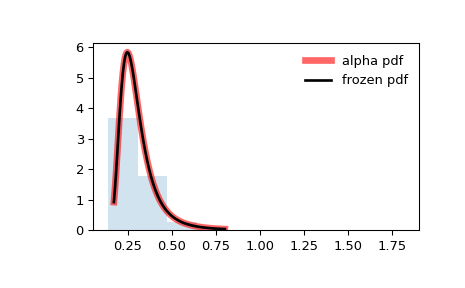scipy.stats.alpha#
- scipy.stats.alpha = <scipy.stats._continuous_distns.alpha_gen object>[source]#
An alpha continuous random variable.
As an instance of the
rv_continuousclass,alphaobject inherits from it a collection of generic methods (see below for the full list), and completes them with details specific for this particular distribution.Notes
The probability density function for
alpha([1], [2]) is:\[f(x, a) = \frac{1}{x^2 \Phi(a) \sqrt{2\pi}} * \exp(-\frac{1}{2} (a-1/x)^2)\]where \(\Phi\) is the normal CDF, \(x > 0\), and \(a > 0\).
alphatakesaas a shape parameter.The probability density above is defined in the “standardized” form. To shift and/or scale the distribution use the
locandscaleparameters. Specifically,alpha.pdf(x, a, loc, scale)is identically equivalent toalpha.pdf(y, a) / scalewithy = (x - loc) / scale. Note that shifting the location of a distribution does not make it a “noncentral” distribution; noncentral generalizations of some distributions are available in separate classes.References
- 1
Johnson, Kotz, and Balakrishnan, “Continuous Univariate Distributions, Volume 1”, Second Edition, John Wiley and Sons, p. 173 (1994).
- 2
Anthony A. Salvia, “Reliability applications of the Alpha Distribution”, IEEE Transactions on Reliability, Vol. R-34, No. 3, pp. 251-252 (1985).
Examples
>>> from scipy.stats import alpha >>> import matplotlib.pyplot as plt >>> fig, ax = plt.subplots(1, 1)
Calculate the first four moments:
>>> a = 3.57 >>> mean, var, skew, kurt = alpha.stats(a, moments='mvsk')
Display the probability density function (
pdf):>>> x = np.linspace(alpha.ppf(0.01, a), ... alpha.ppf(0.99, a), 100) >>> ax.plot(x, alpha.pdf(x, a), ... 'r-', lw=5, alpha=0.6, label='alpha pdf')
Alternatively, the distribution object can be called (as a function) to fix the shape, location and scale parameters. This returns a “frozen” RV object holding the given parameters fixed.
Freeze the distribution and display the frozen
pdf:>>> rv = alpha(a) >>> ax.plot(x, rv.pdf(x), 'k-', lw=2, label='frozen pdf')
Check accuracy of
cdfandppf:>>> vals = alpha.ppf([0.001, 0.5, 0.999], a) >>> np.allclose([0.001, 0.5, 0.999], alpha.cdf(vals, a)) True
Generate random numbers:
>>> r = alpha.rvs(a, size=1000)
And compare the histogram:
>>> ax.hist(r, density=True, histtype='stepfilled', alpha=0.2) >>> ax.legend(loc='best', frameon=False) >>> plt.show()

Methods
rvs(a, loc=0, scale=1, size=1, random_state=None)
Random variates.
pdf(x, a, loc=0, scale=1)
Probability density function.
logpdf(x, a, loc=0, scale=1)
Log of the probability density function.
cdf(x, a, loc=0, scale=1)
Cumulative distribution function.
logcdf(x, a, loc=0, scale=1)
Log of the cumulative distribution function.
sf(x, a, loc=0, scale=1)
Survival function (also defined as
1 - cdf, but sf is sometimes more accurate).logsf(x, a, loc=0, scale=1)
Log of the survival function.
ppf(q, a, loc=0, scale=1)
Percent point function (inverse of
cdf— percentiles).isf(q, a, loc=0, scale=1)
Inverse survival function (inverse of
sf).moment(order, a, loc=0, scale=1)
Non-central moment of the specified order.
stats(a, loc=0, scale=1, moments=’mv’)
Mean(‘m’), variance(‘v’), skew(‘s’), and/or kurtosis(‘k’).
entropy(a, loc=0, scale=1)
(Differential) entropy of the RV.
fit(data)
Parameter estimates for generic data. See scipy.stats.rv_continuous.fit for detailed documentation of the keyword arguments.
expect(func, args=(a,), loc=0, scale=1, lb=None, ub=None, conditional=False, **kwds)
Expected value of a function (of one argument) with respect to the distribution.
median(a, loc=0, scale=1)
Median of the distribution.
mean(a, loc=0, scale=1)
Mean of the distribution.
var(a, loc=0, scale=1)
Variance of the distribution.
std(a, loc=0, scale=1)
Standard deviation of the distribution.
interval(confidence, a, loc=0, scale=1)
Confidence interval with equal areas around the median.